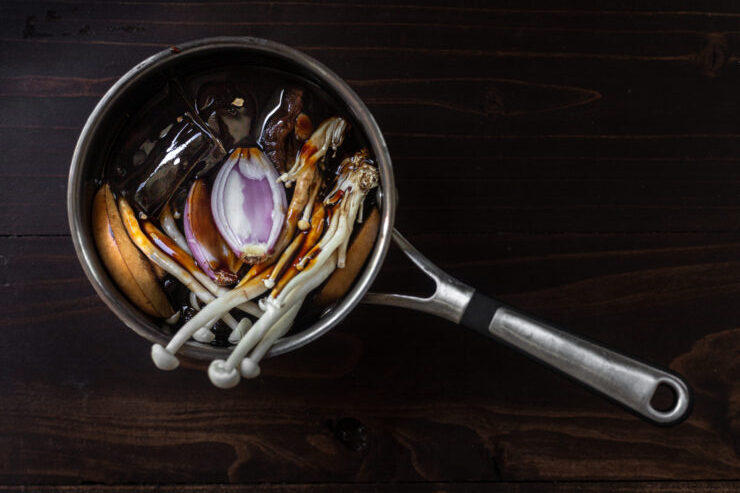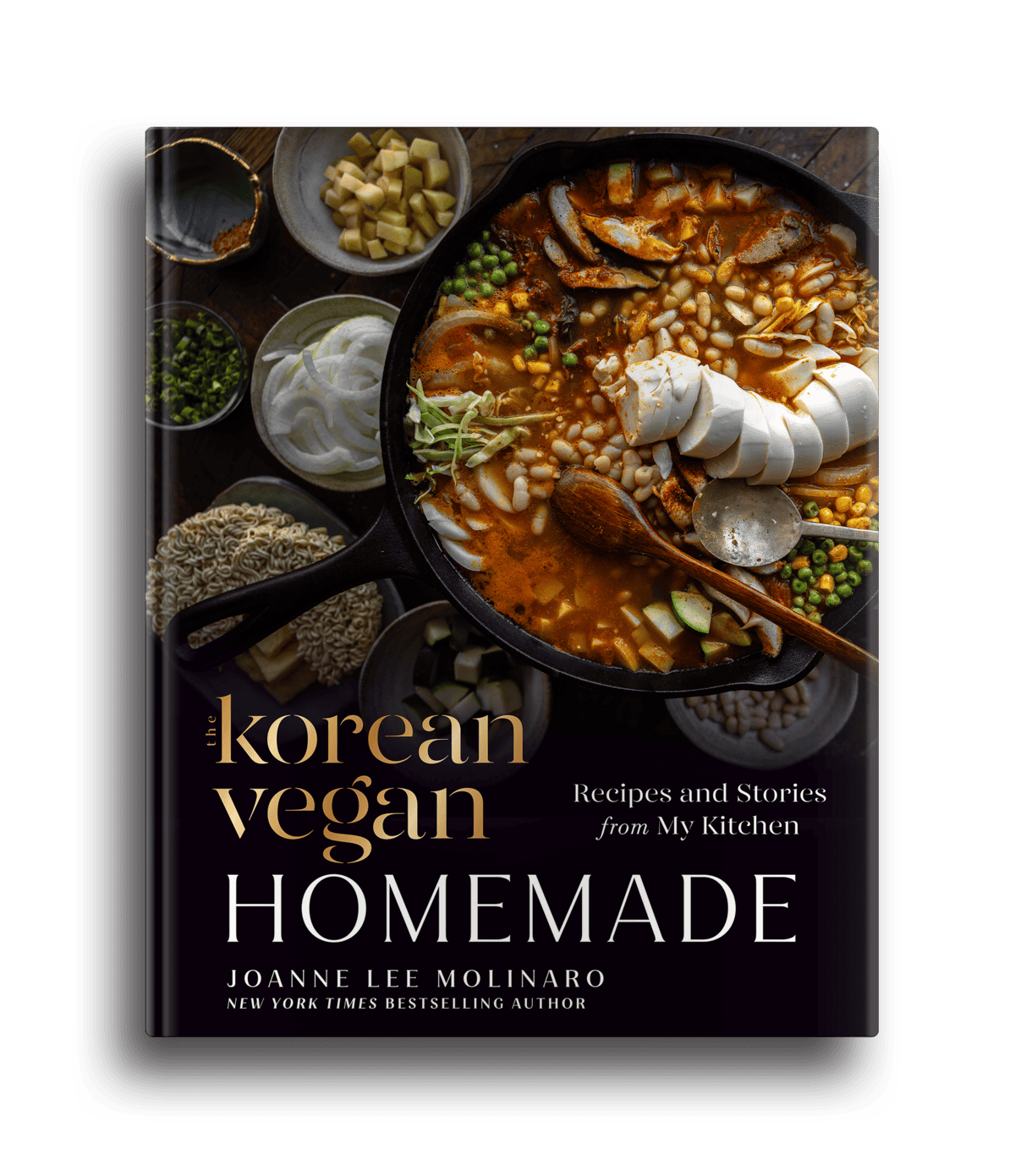The BEST Vegan Fish Sauce (Easy & Delicious).

Easy. Powerful. Delicious.
This vegan fish sauce recipe will catapult to the top of your list of favorite condiments. Easy to make but packing incredible savory flavor, this delicious sauce will be the secret weapon to your vegan pho, your vegetable stir fry, and, most importantly, the Best Vegan Kimchi you’ll ever eat.
Disclaimer: Some of the links in this post may be affiliate links for products I use and love. If you make a purchase after clicking one of those links, I may earn a small affiliate commission, perhaps enough to buy some extra gochujang or gochugaru 🙂
What Is Fish Sauce?
If you love Asian cuisine, you’ve probably come across fish sauce at some point. With its depth of flavor and its capacity to promote fermentation, fish sauce often plays a big role in imparting not just fishy flavor, but elevating the flavors of all the other ingredients in your dish.
Fish sauce or 엑젓 is also one of the most prevalent ingredients in Korean cuisine. The key ingredient of traditional fish sauce (for Korean food, at least) is fermented anchovy, that small fish you sometimes see inside a tin container at the grocery store. The second ingredient to Korean fish sauce is fine sea salt. As you might expect, fish sauce carries both a pungent flavor and fishy scent. This is particularly so of the Korean variety, which tends to have a more intense flavor than the sweeter, more delicate version found in Vietnamese food and Thai cooking.
Is it possible to make Korean food without real fish sauce? Sure, but I’ve got good news: with this vegan fish sauce recipe in your arsenal, you won’t have to! Creating a homemade vegan fish sauce was one of the first things I tackled when I adopted a vegan diet (to make vegan kimchi, duh!). One of the best compliments I’ve ever received on all my recipes was the one from my mother who, after trying my vegan version of fish sauce, gave it a good sniff before adding it to our kimchi and whispered,
“Wow. That tastes like actual fish sauce! How did you do this?”
Why You’ll Love This Recipe for Vegan Fish Sauce.
- So EASY. This recipe takes just a few minutes of prep time. The rest of the magic happens on the stovetop (which requires no labor from you)!
- Gluten-Free Friendly. Just swap the soy sauce out with gluten free soy sauce or coconut aminos and add a few more mushrooms in place of the oyster mushroom sauce and this recipe is gluten-free!
- Versatile. You’ll want to use this vegan fish sauce in everything! Obviously, use it to make the Best Vegan Kimchi, but you can also add it to so many different recipes, like fried rice, braised tofu, and even doenjang chigae!
- Tastes and Acts Like Real Fish Sauce. The best thing about this recipe is that it actually tastes and acts like real fish sauce. One of the reasons fish sauce is such an important component of so many Korean dishes is not just its taste, but its capacity for promoting fermentation. The inclusion of soy sauce and multiple vinegars mimics that property.
How to Make Vegan Fish Sauce Taste Like The Real Thing.
If you’ve never had any fish sauce–vegan or otherwise–this is what it tastes like, in order of prominence:
- Fishy
- Salty
- Sour
- Sweet
Thus, in creating a vegan fish sauce alternative, we need to replicate and balance the above four flavors. There are two keys to a high quality vegan alternative to regular fish sauce: the right ingredients and time. That’s right–you’re going to need to boil your ingredients for a very long time. The good news is, once you get all your ingredients together, there aren’t a lot of steps involved. Just boil and strain!
You’ll discover that many of the items that make up this vegan fish sauce are actually common ingredients (e.g., soy sauce, vinegar, mushrooms) that, when mixed together, create that complex flavor, the one you can’t really put your finger on, but is so prevalent in your favorite Asian recipes. This flavor profile is sometimes referred to as an “umami flavor.” What does “umami” actually refer to, though? Some people describe umami as a “savory taste,” but I like to think of it more as what it makes me do–crinkle up my nose and start salivating. That’s the reaction we’re aiming for with this vegan fish sauce.

Ingredients for this Vegan Fish Sauce and Notes on Substitutions.
The following are the key ingredients to this Vegan Fish Sauce:
- Soy Sauce. Soy sauce serves as the base for this vegan fish sauce recipe. Not only does it check off “salty” in the above flavor checklist, it’s fermented, just like the anchovies in Korean fish sauce. As a fermented ingredient, it also promotes fermentation in what it’s added to (like kimchi!). Finally, Korean fish sauce is a light brown color and since most people also eat with their eyes, soy sauce’s color helps to replicate the look and feel of actual fish sauce. In that regard, Korean soup soy sauce is a great option (this one is gluten free), since it’s saltier than regular soy sauce, but lighter in color. If you can’t use soy sauce, coconut aminos are your best bet.
- Seaweed and Kelp. You can use all different kinds of seaweed for this fish sauce recipe. Just a stroll down the “laver” aisle of your local Asian supermarket will reveal a whole new world of sea plants. Which kind of seaweed should you use? Wakame seaweed (or undaria) or dulse seaweed are both good options for this recipe (I use wakame). I also use dashima or dried kelp to intensify the fishy flavor of this vegan fish sauce.
- Mushrooms. Believe it or not, many varieties of mushroom also impart a fish-forward flavor. For example, dried shiitake mushrooms, combined with oyster and enoki mushrooms, can help develop that umami-induced “crinkle your nose” effect we discussed above. To intensify the umami, this recipe also includes vegetarian “oyster sauce,” which is made primarily out of oyster mushrooms and shiitake mushrooms. If you can’t find vegetarian oyster sauce, just throw in a few more mushrooms.
- Shallots. Shallots aren’t exactly fishy, but they pack a ton of umami (try making your red sauce with shallots next time–you’ll know exactly what I mean). Like fish sauce, shallots also impart a hint of sweetness that balances the bold saltiness of the soy sauce and also pairs exceptionally well with the delicate fishiness of the seaweed.
- Vinegar and Mirin. In addition to fishy and salty, we need to tackle sour. That’s where vinegar and mirin (rice wine) comes in. Like soy sauce, vinegar is both fermented and fermenting and is therefore a logical component of any vegan fish sauce (which is also fermented and fermenting). This vegan fish sauce includes both balsamic and rice vinegar, as well as mirin, all of which remind me a great deal of regular fish sauce in that they are sour and also a little sweet. These are also available at most regular grocery stores.
- Korean Apple Pear. The apple pear does a wonderful job of providing just a little bit of sweetness to this vegan fish sauce. If you can’t find Korean apple pear, you can substitute a Fuji apple or any other sweet apple.
Step-by-Step Guide to Making Vegan Fish Sauce.
First, add all of your ingredients to a small saucepan, together with filtered water. Bring the entire mixture to a boil and reduce your heat and allow the liquid to simmer until it has reduced considerably from the original volume (about 90 minutes to 2 hours). Turn off your burner and set the mixture aside to cool completely.
Tip: Thoroughly wash your shallot, garlic cloves, and apple pear with the peels on. Do not remove the peels when you add them to the pot–the peels will exponentially increase the amount of flavor imparted by these ingredients.
Once your liquid has cooled, strain it through a sieve, strainer, or chinois (my husband actually bought me a chinois for Christmas one year and it remains one of my favorite gifts of all time!!) into an airtight container (I usually use an 12 ounce mason jar).

Stick that bad boy in the fridge and you’ll be set with the best vegan fish sauce for your vegan kimchi, vegetable stir-fries, dumpling dipping sauce, and all manner of your favorite Asian fare!
Frequently Asked Questions.
Can’t you just buy vegan fish sauce these days?
Absolutely. However, they’re quite pricey (I saw one small bottle for nearly $30) and, often times, they’re not much better than really salty soy sauce. Finally, many vegan fish sauce brands are not easily accessible–you’ll have to shop online or at specialty stores to find them.
How long does vegan fish sauce stay good for?
If you keep your vegan fish sauce in the refrigerator, it’ll last for several months.
What are some Korean dishes that use fish sauce?
Fish sauce makes its way into so much of Korean food, not just kimchi. Many of the side dishes (or banchan), including those that are just sauteed vegetables, have a drop or two of fish sauce in them. Korean stews (or chigae) also often contain fish sauce. In other words, you’ll find yourself adding this vegan fish sauce to many many recipes!
Recipe Card

The BEST Vegan Fish Sauce
Equipment
- 1 small sauce pan
- 1 sieve or chinois
Ingredients
- 1 1/2 cup soy sauce (preferably soup soy sauce)
- 6 dried shiitake mushrooms
- 1/2 cup oyster mushrooms
- 1/4 cup enoki mushrooms
- 1/4 cup Korean apple pear (can substitute Fuji apple or other sweet apple)
- Five 2-inch pieces dashima (dried kelp or kombu)
- 2 tablespoons dried wakame
- 2 tablespoons mirin
- 2 tablespoons balsamic vinegar
- 2 tablespoons rice vinegar
- 1 teaspoon whole black peppercorns
- 1 teaspoon oyster mushroom sauce
- 2 medium shallots (washed, unpeeled, and sliced in half)
- 4 medium cloves garlic (washed, unpeeled, tips trimmed off)
Instructions
- Combine the soy sauce, mushrooms, wakame, dashima, balsamic vinegar, rice vinegar, mirin, peppercorns, mushroom sauce, apple pear, shallots, and garlic with 3 cups of filtered water in a saucepan. Bring the mixture to a boil. Then reduce heat and allow the mixture to simmer until the sauce has reduced to about half the original volume (anywhere from 90 minutes to 2 hours). Remove from heat and allow the liquid to cool completely.
- Pour the contents of the pot through a sieve, chinois, or similar strainer into an airtight container. Store in the refrigerator for up to 3 months. Freeze for additional use.










Hi-thank you very much for the wonderful recipe. I would like to ask-is there anywhere I can find your old recipe for fishy sauce? I seem to recall one where only shimeji mushrooms were used along with shallots and a couple other things, but cannot find it, and I currently only have the ingredients for that sauce (although I will be sure to make this one next time)!
Can this recipe use coconut amino soy sauce? My husband can’t have soy due to it causing him kidney stones
Hi Priscilla, yes! You can use coconut aminos as a soy sauce substitute. Here’s the explanation: traditional soy sauce contains soy, so if you are allergic, there are some great no-soy alternatives, including this no-soy, gluten-free sauce. Of course, you can also use coconut aminos.
Wow! I wasn’t sure if this sauce would be fishy enough. First, it is really easy to make. Second, I wasn’t expecting the intense flavour and the taste surpassed my expectations. It is almost more pungent and complex than the real fish sauce. Joanne’s sauce is concentrated as well so would need less in a recipe. I am going through all your recipes and so far all the recipes are fantastic. I am a part time vegan but if everything tastes this good, I might reconsider? Thank you for sharing this recipe.
Congratulations on your first book and your upcoming book. 👏🏼👏🏼👏🏼👏🏼👏🏼
The secret sauce!
The jump to recipe button isn’t working
Hi Joanne, I was wondering if you have this recipe in metric units? Trying to fathom the mushroom quantities in cups is tricky for me :)) Looking forward to making this, in preparation for homemade kimchi! Many thanks!
What to use instead of oyster mushroom sauce? I can’t buy it in my country.
Hi Dori! I would sub in Chinese vinegar or balsamic!
Amazing sauce, full bodied and packed with flavor. Finally I can think to make my soups again 🙏
This sounds delicious. But what about a substitute for saeujeot?
Hello, stopping by to comment that this is thus far, by FAR, the best fish sauce substitute recipe I’ve seen. You got it right- since fish can’t be used, at least do what you can to bring the *flavor of the ocean* to the sauce. People are getting this all wrong, trying to imitate the flavor without brainstorming how to bring the *ocean* into the sauce. I was thinking of how I would do that after seeing the endless abominations of ‘soy sauce+vinegar, voila’ – so inaccurate flavor profile as to be crass – and what I ended up with was a more crude version of your recipe!! And great idea with the shallots, with their more delicate flavor.
This recipe calls for far more ingredients and is more complicated than others, but *fish sauce is complex*, it can’t be imitated with 2 ingredients.
Finally- they can be hard to get ahold of but I see them at the ‘fancy’ grocer sometimes- have you ever used/considered lobster mushroom? I swear they smell and taste unmistakably of seafood.
Thanks for your work making the world a tastier place!
Sloan, thank you so much for stopping by to say this!! It means so so much to me!! You are so right–fish sauce IS complex and if you really want as many of the “benefits” of fish sauce as possible, it takes a little work, right? As to lobster mushrooms, honestly, i’ve never even SEEN them by where I live. It’s hard to find much beyond enoki, trumpet, oyster, and shiitake around here. But I’ll definitely give it a try if I see them! Thank you for the suggestion!!
I’m so psyched to try this recipe – it opens up a whole world of flavor for plant-based eating.
One question – what is the oyster mushroom sauce? I looked but didn’t find a recipe for it on your site 🙂 And no bottled product that seems to match what you are calling for in the recipe. Thanks in advance!
I found this: Lee Kum Kee Vegan Gluten-Free Oyster Flavored Sauce
I also couldn’t find a recipe for it on here, so I hope this is okay to post – I did find this on another blog [ https://www.okonomikitchen.com/vegetarian-oyster-sauce/ ]
Hi Anna, Thanks for sharing the recipe link!! 🙂
Hi Dani, oyster mushroom sauce is a savory condiment made from oyster mushrooms (not actual oysters) and other seasonings. It’s often used in Asian cooking, especially Chinese cuisine, to add umami flavor to stir-fries, vegetables, and meat dishes. I hope this helps!
I don’t have all these mushroom varieties in my country. I only have shiitake and white ´Champignon de Paris’. Can I use mushroom season to replace the other mushrooms ?
So I just made my “fishy” sauce, and it definitely has that umami flavor, but I am also one that doesn’t like to waste ingredients… what do you do with the stuff that is strained out of the liquid?
I pour in a few cups of water and cook it some more, creating a broth for ramen. Then cut up the mushroom and used them in stir fried with other vegetables and eat with rice
Glendy–that is such a great idea! Thank you for sharing!
I blended my leftover strained ingredients with some water, then added it to a pot, turned on the heat, added more water and a can of coconut cream, threw a whole russet potato in for 20 mins to soak up the salt, took the potato out when it was tender, then turned off the heat and it was perfect!!! finished it with lemon and green onion to serve! 🙂
Fell in love with kimchi recently and I follow this chef on IG so this was a must try. I’ll be making the lazy kimchi this week and I’m so excited. So far the fish sauce I definitely simmered a little too heavy because my yield was about half what it should have been. Regardless, very umami and not too fishy which is to my preference. I did add extra shiitake since I’m obsessed with them anyways. I will always chose making everything instead of buying store bough so as a first time kimchi experience I can’t be more excited!
Alex!! I’m tickled you think I’m a “chef”!! But I’m a homecook just like you and I’m so glad you liked this recipe. You may have boiled it too long, but honestly, it’s less about volume and more about flavor. Let that be your guide. And I truly cannot WAIT for you to experience homemade kimchi. You will NEVER go back to store bought after this!!!
Is there any substitute for the kelp, wakame? I am anaphylactic with all shellfish and sea weeds. I would love to have a good fish sauce. PD: I cannot use anchovies either.
Hi Judith. I thought about this question a lot and even consulted with numerous other recipe developers and chefs. Our best recommendation would be to make this sauce without the kelp and seaweed and use more shiitake and oyster mushrooms. While they won’t impart the strongest “fishy” flavor, they will deepen the umami flavor of this sauce. I hope this helps!
To get that fishy flavor without seaweed, I think white wild oyster mushrooms have a more strongly fishy flavor than others. Wild ginger, if you’re into foraging, is a little fishy. Oyster leaf herb (Mertensia maritima) is a plant that you could cultivate that smells like mushrooms and oysters.
Tickled as a natives-focused ecologist to see the Mertensia genus mentioned. Yes, the NA-native Mertensia bluebells have both adorable flowers and fishy leaves – but if they’re ephemeral like Mertensia virginica is, I would like to know how easily the leaves could be stored/frozen/dried for use the rest of the year.
I would also exercise caution with wild ginger (if you do mean Asarum canadense and relatives) since they are high in toxic aristolochic acid. As far as I know, the only usage that is considered safe is to boil the roots since the acid is not very water-soluble.
I can confirm that this is the best vegan fish sauce I’ve tried! SO much better than store-bought. Thank you for the recipe!
I’m lucky to have this as a staple in my (our) kitchen! So good!!